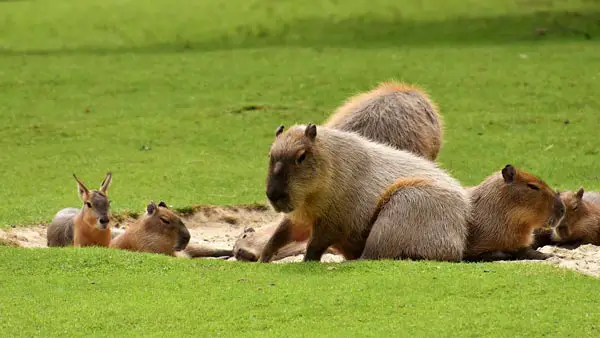Why Are Capybaras So Friendly? The enormous friendly rodents known as capybaras, which are native to South America, frequently pique our interest. It’s a characteristic that distinguishes them from other animals.

What makes capybaras so friendly toward both their own species and even people is a mystery. This fascinating component of capybara behavior can be better understood by comprehending their social structure and evolutionary history.
These creature have become extremely sociable through evolution, flourishing in communities known as “harems.” They have a strong feeling of dependency and collaboration thanks to their social structure, which is shown in how accessible they are.
Here in this blog post we will see why are capybaras so friendly? and behavior of capybara with other animals.
A Brief Overview of Capybaras
This animal is the largest animal of the Indian pig family and is native to South America. This creature is
the largest rodent in the world and sometimes reaches a meter in length. The leaf eater does not have a
tail; This animal looks like a pig and the guinea pig is one of its close relatives.
Capybara is often found near water. This creature is very social and can be found in large groups of 100 or in small groups of 10-20 The leaf eater is not a threatened species, although it is hunted for its skin and meat.-
Why Are Capybaras So Friendly?
The great friendliness of capybaras is a result of their long evolutionary history and extremely social
character. Because they have evolved to live in close-knit communities, these huge rodents encourage
cooperation and reliance.
They have a strong feeling of trust and sociability toward their own kind because to this social system. Additionally, capybaras exhibit a unique emotional intelligence that enables them to forge bonds with both humans and members of their own species.
Capybaras stand out as one of the most accessible and sociable animals in the animal kingdom due to their special evolutionary features and emotional sensitivity.
Leaf-eaters are excellent swimmers and can remain fully submerged for up to five minutes, and can
sleep in the water if needed to escape predators. They are very good swimmers, divers and are very
comfortable in water, taking refuge in water when threatened. They use their relatively webbed feet for
swimming, and the fat stored in their bodies helps them stay afloat better.
The Social Nature of Capybaras
The extremely sociable behavior of capybaras is well known and distinguishes them from other
members of the animal world. These enormous rodents, which are native to South America, live in
tightly linked communities called “harems.”
Their evolutionary history is heavily influenced by this communal way of living, which is essential to their survival. Living in groups gives them access to a larger variety of resources and group defense against predators.
Capybaras display complex social activities in these harems, such as grooming, vocalizations, and cooperative parenting. Their capacity to recognize and react to the emotions of their fellow group members is another proof of their deep social ties. They grow closer and more trusting of one another because to this emotional intelligence.
Unique characteristics of capybara social structure
These mammals are herbivores and their main food is grasses and aquatic plants as well as fruits and
tree bark. They also feed on aquatic plants and grasses. Capybaras stand out among other animals
thanks to their particularly complex social structure. They gather in tight-knit communities known as “harems,” which are typically headed by a dominant male and comprise multiple females and their
young.
The group’s cooperative behaviors are encouraged and maintained by the hierarchical structure.
Along with playing a crucial role in reproduction, the dominant male is also in charge of providing
leadership and protection. In capybara social dynamics, communication is crucial.
A variety of vocalizations are employed to transmit messages, coordinate movements, and alert possible dangers. A noteworthy example of cooperative parenting is seen in capybaras, who include not only the parents but also other group members in raising young.
Capybara with Other Animals
This common question comes in everyone’s mind that does Capybara get along with other animals? If answer to this question is yes, generally capybaras are friendly with every animals. Because of the capybara’s friendly nature, they have made friends with every other animal from dogs and cats to birds.
Conclusion
We hope you understand why capybaras are so friendly? Capybaras get along really well with other animals.
If you still having any question about this guide please let us know in the comment section below, will definitely help you.
Also Read:
- How Much Does a Capybara Cost?